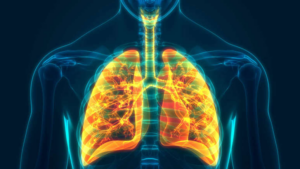The respiratory illnesses you should be aware of
4 min read
Your cough, runny nose, and fatigue may resemble the flu or a common cold. However, it’s essential to recognize that these symptoms could indicate various respiratory illnesses. Sinusitis, pneumonia, and tuberculosis are a few examples. Early detection plays a crucial role in expediting recovery.
Asthma: what is it?
Asthma is a condition marked by persistent inflammation in the respiratory passages. The bronchi can become easily irritated and constrict, obstructing the flow of air into the lungs.

Asthma: causes
Common irritations include dust, animal hair, and cigarette smoke, often causing discomfort.Some foods, such as eggs, soy, chocolate, shrimp, and peanuts, can trigger asthma attacks for individuals with food allergies.
Exercise-induced asthma is a form of asthma where air passages constrict during intense physical activity.
How to treat asthma?
A doctor can diagnose asthma through a straightforward examination. Treatment involves taking oral and inhaled medications, which help to relax the respiratory passageways and improve breathing.
What is bronchitis?
Bronchitis occurs as acute or chronic with inflammation of airways.
Bronchitis: causes
Acute bronchitis arises from a viral infection and often coincides with a cold or flu. Chronic bronchitis, on the other hand, can be triggered by pollution or cigarette smoke.
Bronchitis: symptoms
Symptoms of the illness include a wet cough, fatigue, fever, difficulty breathing, and shortness of breath among others.

Bronchitis: treatment
After receiving a diagnosis, treatment typically involves taking cough medicine or other medications recommended by a doctor. It is important to consult a specialist before attempting any self-treatment for the infection.
In addition to medication, there are alternative methods to recover from bronchitis, such as abstaining from smoking and drinking plenty of fluids.
What is sinusitis?
Sinusitis is a frequently occurring respiratory ailment. It involves the buildup of mucus in the sinus cavities of the face, leading to inflammation and swelling. Bacteria, viruses, and fungi can all be causes of sinusitis, in addition to allergies.
Sinusitis: symptoms
If you experience discomfort or pressure in your face, decreased sense of smell, or an earache, you could be dealing with sinusitis.
Sinusitis: diagnosis
A nasal endoscope can be used to make a diagnosis. By inserting a tube with fiber-optic light into the nose, doctors are able to view the internal area.
Sinusitis: treatment
There are various steps you can take to relieve symptoms alongside medication prescribed by your doctor. These include maintaining cleanliness in your home, preventing the buildup of dust, limiting air conditioning, and nasal irrigation.
What is COPD?
Chronic obstructive pulmonary disease is a respiratory disease that is often confused with asthma as it presents with shortness of breath. However, with asthma, the shortness of breath is acute and isolated in attacks. With COPD, this symptom worsens over time
COPD: causes
COPD occurs when the bronchi lose elasticity, causing difficulty in expelling air from the lungs during exhalation.
COPD: symptoms
Symptoms typically emerge in individuals aged 35 to 40 and are commonly linked to tobacco consumption. Initial manifestations entail coughing and an abundance of phlegm. Afterwards, common symptoms consist of feeling out of breath, experiencing excessive tiredness, and having a lack of energy while performing basic activities like climbing stairs.
COPD: treatment
A doctor can provide medication to treat the illness. It is also important to stop smoking and take breaks before performing daily activities, like taking a shower or driving.
Pneumonia: what is it?
This disease is triggered by an infection in the respiratory system, which can be caused by a virus, bacteria, or fungus.
Pneumonia: causes
The illness can be caused by many different germs, but most cases are due to bacteria and viruses present in the air. Pneumonia can be caused by various factors such as smoking, persistent colds, or significant changes in temperature. Common symptoms of the illness may include a dry cough, high fever, chest pain, night sweats, and nausea.
Pneumonia: treatment
Blood tests and chest X-rays are utilized by doctors to diagnose the illness. Treatment involves administering antibiotics and, in certain instances (particularly with elderly patients), needs a hospital admission.
What is tuberculosis?
Tuberculosis is recognized as a highly grave illness, caused by a bacterial infection that primarily targets the lungs.
Tuberculosis: transmission
Tuberculosis is an infectious disease that spreads through saliva when someone coughs, speaks, or sneezes. Therefore, it is crucial to diagnose it early to prevent its transmission.
Tuberculosis: causes
An increased risk of getting the illness can occur when the immune system is weakened due to an unhealthy diet, smoking, or excessive alcohol consumption.
Tuberculosis: treatment
One of the main symptoms of tuberculosis is a cough that initially has no mucus but later produces liquid, pus, or blood. Additional indications include fever, night sweats, paleness, and decreased appetite. This illness can be treated with antibiotics prescribed by doctors.
Consult a specialist
Take care of your well-being. If you experience any of these respiratory signs, consult a specialist.



